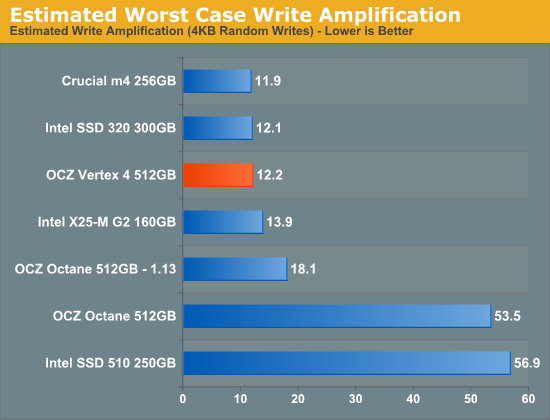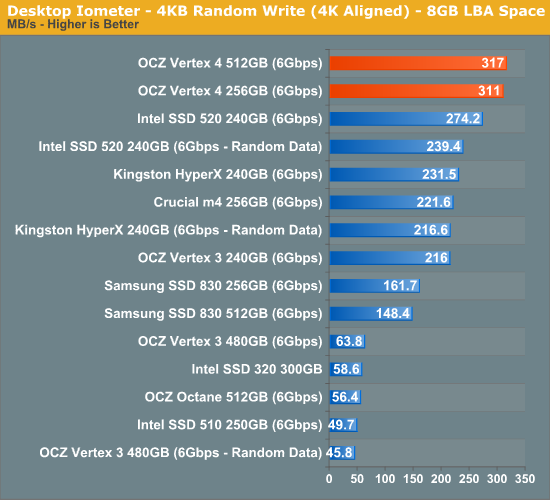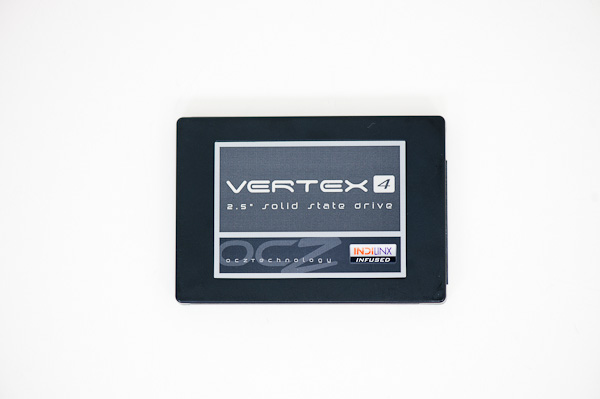OCZ Vertex 4 Review (256GB, 512GB)
by Anand Lal Shimpi on April 4, 2012 9:00 AM ESTThirteen months ago OCZ announced its intention to acquire Indilinx, the SSD controller maker that gave Intel its first taste of competition in the consumer market in 2009. Eight months later, OCZ launched its first post-acquisition SSD based on Indilinx silicon. Today, just five months after the launch of the Octane, OCZ is officially releasing the Vertex 4 – based on its Indilinx Everest 2 silicon. In less than a year, OCZ has brought to market more Indilinx powered controllers than Indilinx did in the previous three years. It's rare that you see the fruits of acquisition so quickly, but if there's anything OCZ's CEO Ryan Petersen is good at it's pushing for an aggressive schedule.
Rather than call this drive the Octane 2, OCZ went with Vertex 4, indicating its rightful place at the top of OCZ's SSD lineup. The implications run even deeper. It marks the first time in two years that a Vertex drive will ship without a SandForce controller inside. Make no mistake, while Octane was a shot across SandForce's bow, Vertex 4 means war. While OCZ continues to ship tons of SandForce controllers, the future for the company is Indilinx. The Vertex 4 is just the beginning. OCZ will continue to ship Vertex 3 in parallel, and should a future SandForce controller make competitive sense to use OCZ will definitely consider it, but the intention is to build the fastest silicon internally and use it as much as possible.
The dramatic departure in naming also embodies just how different Everest 2 is from the original Everest controller. OCZ claims there's minimal shared code between the Octane and Vertex 4 firmware, and the two drives perform very differently. Write amplification was always a concern with the Octane - it is no longer a major issue with the Vertex 4. OCZ and its Indilinx team have reduced write amplification to roughly the levels of Intel's controllers:

Indeed write performance is improved significantly as a result. A look at the spec sheet gives us the first indication of what's to come:
| OCZ SSD Comparison | ||||||
| OCZ Vertex 4 | OCZ Vertex 3 | OCZ Octane | OCZ Vertex 2 | |||
| Current NAND | 25nm IMFT MLC | 25nm IMFT MLC | 25nm IMFT MLC | 25nm IMFT MLC | ||
| Capacities | 128, 256, 512GB | 60, 90, 120, 240, 480GB | 128, 256, 512GB, 1TB | 60, 120, 240GB | ||
| Controller | Indilinx Everest 2 | SF-2281 | Indilinx Everest | SF-1221 | ||
| Max Seq Read | 535 MB/s | 550 MB/s | 480 MB/s | 285 MB/s | ||
| Max Seq Write | 475 MB/s | 500 MB/s | 330 MB/s | 275 MB/s | ||
| Max Random Read | 95K IOPS | 60K IOPS | 26K IOPS | - | ||
| Max Random Write | 85K IOPS | 85K IOPS | 35K IOPS | 50K IOPS | ||
| AES-256 Encryption | Yes | Yes | Yes | No | ||
Regardless of the nature of the data (compressible or incompressible), the Everest 2 powered Vertex 4 promises better random write performance than any other consumer SSD on the market today. And it delivers:

Random write speed is nothing short of incredible. OCZ is able to equal SandForce's write speed on highly compressible data without resorting to any sort of data compression. This is a purely algorithmic advantage. While the original Everest was a work in progress by the time OCZ acquired the company, Everest 2 is the first Indilinx project OCZ had complete control over. Apparently OCZ's CEO, Ryan Petersen had a lot of his own input built into this design.
| OCZ Vertex 4 Lineup | |||||
| 512GB | 256GB | 128GB | |||
| NAND Configuration | 16 x 32GB 25nm Intel sync NAND | 16 x 16GB 25nm Intel sync NAND | 8 x 16GB 25nm Intel sync NAND | ||
| DRAM | 2 x 512MB DDR3-800 | 2 x 512MB DDR3-800* |
2 x 512MB DDR3-800* | ||
| Controller | Indilinx Everest 2 | Indilinx Everest 2 | Indilinx Everest 2 | ||
| Max Seq Read | 535 MB/s | 535 MB/s | 535 MB/s | ||
| Max Seq Write | 475 MB/s | 380 MB/s | 200 MB/s | ||
| Max Random Read | 95K IOPS | 90K IOPS | 90K IOPS | ||
| Max Random Write | 85K IOPS | 85K IOPS | 85K IOPS | ||
| MSRP | $699 | $349 | $179 | ||
The Vertex 4 will be available in three capacities initially – 128GB, 256GB and 512GB, with a 1TB version following. Drives should be available today but in very limited quantities, and likely only 128GB capacities at the start. MSRP is fairly competitive with other 6Gbps drives on the market today:
| SSD Pricing Comparison | |||||
| 128GB | 256GB | 512GB | |||
| Crucial m4 | $154.99 | $299.99 | $549.99 | ||
| Intel SSD 520 | $184.99 | $344.99 | $799.99 | ||
| Samsung SSD 830 | $174.99 | $299.99 | $779.99 | ||
| OCZ Octane | $199.99 | $339.99 | $849.99 | ||
| OCZ Vertex 3 | $199.99 | $339.99 | $1199.99 | ||
| OCZ Vertex 4 | $179 MSRP | $349 MSRP | $699 MSRP | ||











127 Comments
View All Comments
rw1986 - Friday, April 6, 2012 - link
This seems very speculative. OCZ has admitted collaboration with Marvell (for example on their new Kilimanjaro platform for the Z-Drive R5 PCIe SSD).here is the link to the OCZ Everest 2 announcement: http://www.ocztechnology.com/aboutocz/press/2012/4...
In the announcement, OCZ makes some specific claims surrounding Everest 2 -- for example:
"the Everest 2 SSD controller reduces latency to 0.043ms for read operations and 0.026ms for write operations, yielding an improvement of approximately 80 percent over the previous Everest SSD controller generation"
"The advanced, multi-level BCH ECC engine with progressive error correction adapts to the specific error characteristics of different NAND devices. The programmable ECC engine achieves an effective correction power of up to 128 bits per 1KB of data while significantly reducing the uncorrectable bit error rate (UBER)."
The Marvell sheet emphasizes some similar things (high performance, error correction technology) but these are more general claims than what OCZ has listed in their Everest 2 spec sheet.
Is the foundation of your assumption that Everest 2 is just the 88SS9187 that the spec sheets sound similar? That does not seem conclusive to put it generously
jwilliams4200 - Saturday, April 7, 2012 - link
There is no hard evidence that is publicly available since OCZ is keeping it quiet for obvious reasons.The Octane uses a rebadged Marvell 88SS9174, and the Vertex 4 uses a rebadged Marvell 88SS9187.
rw1986 - Saturday, April 7, 2012 - link
I'm just curious how you can make these claims so authoritatively when, as you say "there is no hard evidence that is publicly available" to support your position.What you seem to be suggesting is that OCZ made a 32 million dollar acquisition in April of 2011 (Indilinx) and then decided to simply license and rebadge controllers from Marvell rather than build internally (which is completely contrary to what OCZ has told investors and the public). On a Thursday conference call OCZ's CEO was quite adamant that Everest 2 is completely their IP and will improve their profit margin strucutre as a result (since they don't have to pay a fee to Sandforce for each controller as before). If what you are saying is true then OCZ has misled their investors at best.
This is a pretty serious accusation you are making here and it would be nice if you had a little more to say in support of it than "trust me, i know." If you were really in a position to know then I doubt you would be posting on the comments section at AT.
I'd be interested to hear some experts weigh in on this exchange. How could we verify or disprove that the Everest 2 is really not Indilinx but instead a rebadged 9187? Surely some analysis can be done on the ASIC
jwilliams4200 - Saturday, April 7, 2012 - link
It isn't very important to me either way, since I have no financial interest. But OCZ has a history of dishonesty, and it bothers me to see them get away it.If it is important to you, you could start by contacting the appropriate people at OCZ and asking whether the controllers in the Octane and the Vertex 4 have similar or identical circuits with Marvell controllers.
jwilliams4200 - Wednesday, April 11, 2012 - link
http://www.anandtech.com/show/5741/ocz-confirms-oc...hackztor - Friday, April 13, 2012 - link
Good job on being correct. I think alot of people feel betrayed again by ocz. Last time i will purchase their product no matter what.pookguy88 - Wednesday, April 4, 2012 - link
so wait, right now they'll (256gb, 512gb) ship with 1gb DRAM but later on 512mb? Is it just me or is that going to be a huge deal for customers once they realize that they basically got jacked 512mb of RAM vs early adopters?pattycake0147 - Wednesday, April 4, 2012 - link
I inferred that the smaller drives will ship with 1GB but only 512MB will be used on the drive.Voo - Wednesday, April 4, 2012 - link
Considering that was explicitly stated in the article there's not much to infer here is it?"Oh no I was jacked from 512mb that were deactivated anyhow - what a scandal!"
antef - Wednesday, April 4, 2012 - link
Why is your standard recommendation still the Samsung SSD 830? Given the performance, prices, and most notably, the incredibly excellent reviews on sites like Newegg, the Crucial M4 would still be my recommendation to new shoppers.